Performance Management: Measurement and Control Discussion
VerifiedAdded on 2023/01/12
|7
|1588
|54
Report
AI Summary
This report provides a comprehensive overview of performance management, exploring its significance in achieving organizational goals. It delves into the measurement of performance and control mechanisms within various organizational settings, highlighting the importance of Key Performance Indicators (KPIs) in both manufacturing and service industries. The report compares and contrasts KPIs used in these sectors, such as capacity utilization and on-time delivery in manufacturing versus employee satisfaction and service renewal rates in the service industry. It also addresses the challenges in measuring performance, particularly in the service sector, due to factors like simultaneity and heterogeneity. Furthermore, the report differentiates between financial and non-financial factors within performance management, emphasizing the focus on short-term versus long-term success and the types of reports used for each. The conclusion summarizes the vital role of KPIs in performance analysis and control.
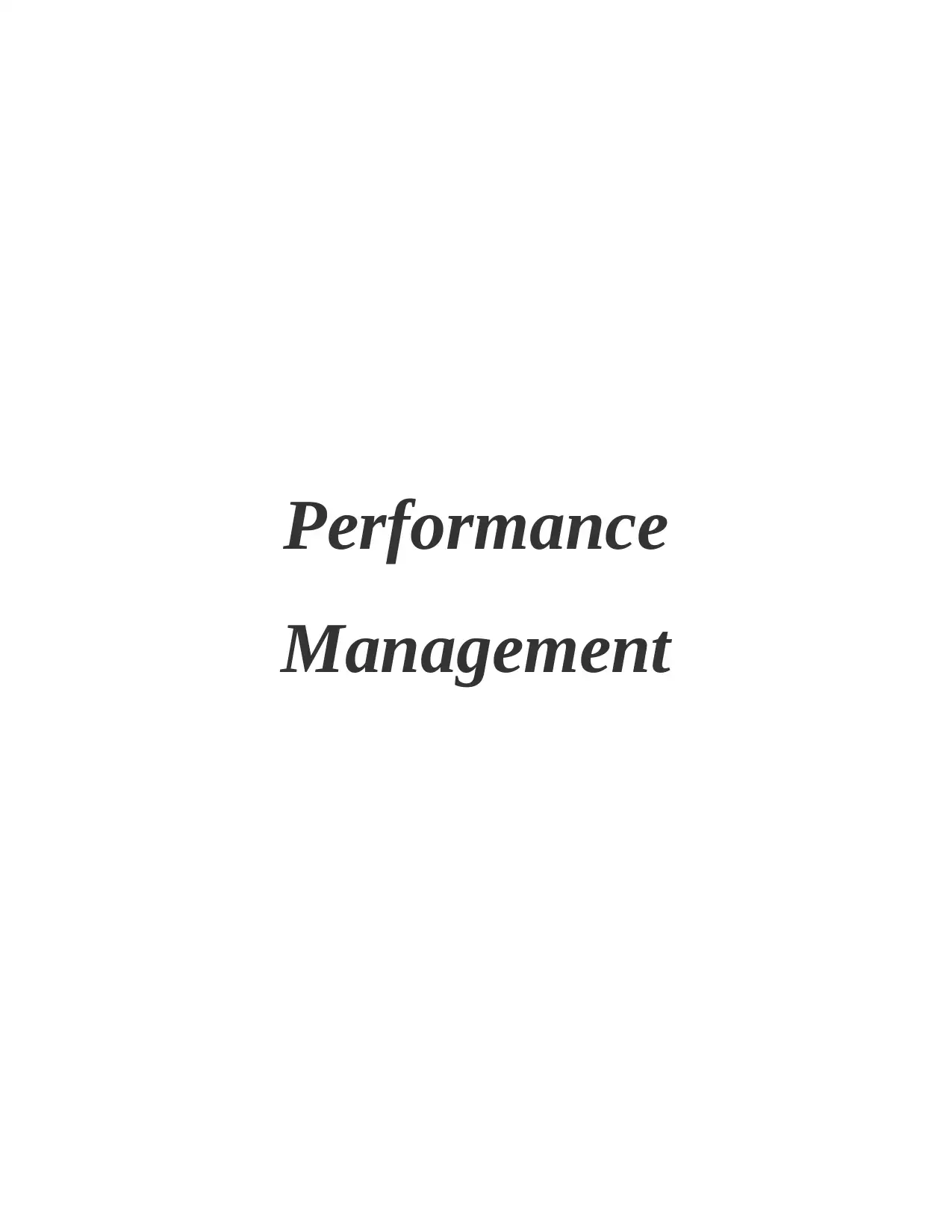
Performance
Management
Management
Paraphrase This Document
Need a fresh take? Get an instant paraphrase of this document with our AI Paraphraser
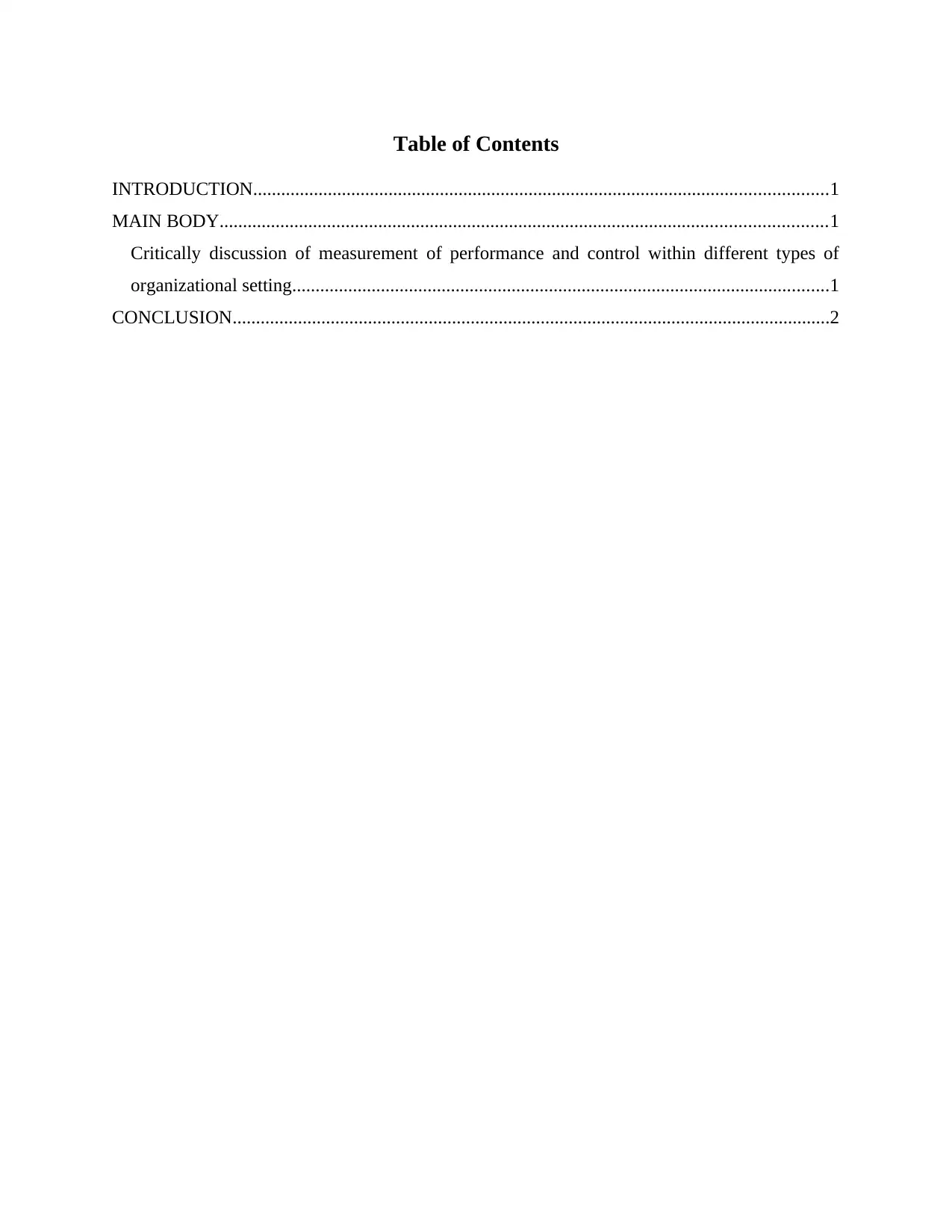
Table of Contents
INTRODUCTION...........................................................................................................................1
MAIN BODY..................................................................................................................................1
Critically discussion of measurement of performance and control within different types of
organizational setting...................................................................................................................1
CONCLUSION................................................................................................................................2
INTRODUCTION...........................................................................................................................1
MAIN BODY..................................................................................................................................1
Critically discussion of measurement of performance and control within different types of
organizational setting...................................................................................................................1
CONCLUSION................................................................................................................................2
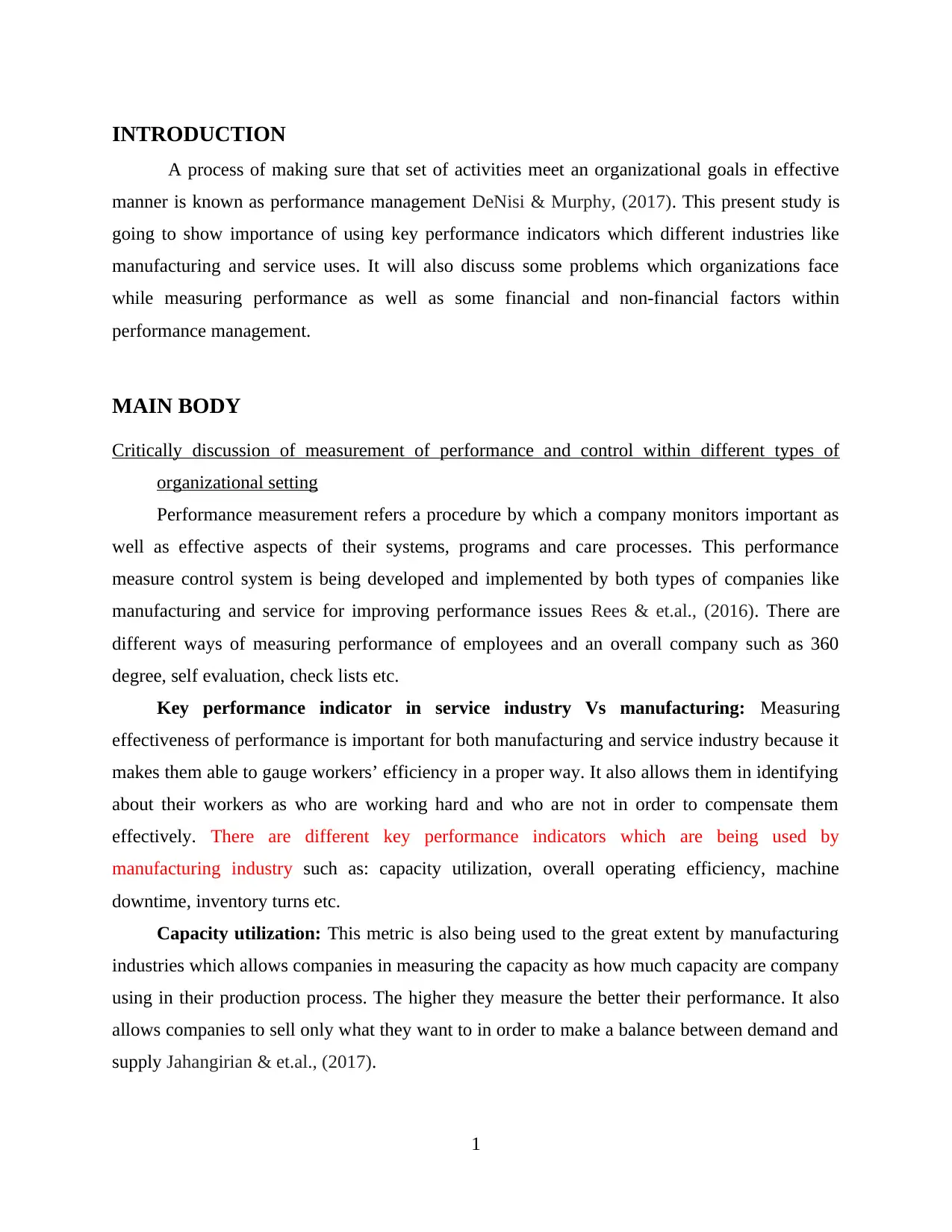
INTRODUCTION
A process of making sure that set of activities meet an organizational goals in effective
manner is known as performance management DeNisi & Murphy, (2017). This present study is
going to show importance of using key performance indicators which different industries like
manufacturing and service uses. It will also discuss some problems which organizations face
while measuring performance as well as some financial and non-financial factors within
performance management.
MAIN BODY
Critically discussion of measurement of performance and control within different types of
organizational setting
Performance measurement refers a procedure by which a company monitors important as
well as effective aspects of their systems, programs and care processes. This performance
measure control system is being developed and implemented by both types of companies like
manufacturing and service for improving performance issues Rees & et.al., (2016). There are
different ways of measuring performance of employees and an overall company such as 360
degree, self evaluation, check lists etc.
Key performance indicator in service industry Vs manufacturing: Measuring
effectiveness of performance is important for both manufacturing and service industry because it
makes them able to gauge workers’ efficiency in a proper way. It also allows them in identifying
about their workers as who are working hard and who are not in order to compensate them
effectively. There are different key performance indicators which are being used by
manufacturing industry such as: capacity utilization, overall operating efficiency, machine
downtime, inventory turns etc.
Capacity utilization: This metric is also being used to the great extent by manufacturing
industries which allows companies in measuring the capacity as how much capacity are company
using in their production process. The higher they measure the better their performance. It also
allows companies to sell only what they want to in order to make a balance between demand and
supply Jahangirian & et.al., (2017).
1
A process of making sure that set of activities meet an organizational goals in effective
manner is known as performance management DeNisi & Murphy, (2017). This present study is
going to show importance of using key performance indicators which different industries like
manufacturing and service uses. It will also discuss some problems which organizations face
while measuring performance as well as some financial and non-financial factors within
performance management.
MAIN BODY
Critically discussion of measurement of performance and control within different types of
organizational setting
Performance measurement refers a procedure by which a company monitors important as
well as effective aspects of their systems, programs and care processes. This performance
measure control system is being developed and implemented by both types of companies like
manufacturing and service for improving performance issues Rees & et.al., (2016). There are
different ways of measuring performance of employees and an overall company such as 360
degree, self evaluation, check lists etc.
Key performance indicator in service industry Vs manufacturing: Measuring
effectiveness of performance is important for both manufacturing and service industry because it
makes them able to gauge workers’ efficiency in a proper way. It also allows them in identifying
about their workers as who are working hard and who are not in order to compensate them
effectively. There are different key performance indicators which are being used by
manufacturing industry such as: capacity utilization, overall operating efficiency, machine
downtime, inventory turns etc.
Capacity utilization: This metric is also being used to the great extent by manufacturing
industries which allows companies in measuring the capacity as how much capacity are company
using in their production process. The higher they measure the better their performance. It also
allows companies to sell only what they want to in order to make a balance between demand and
supply Jahangirian & et.al., (2017).
1
⊘ This is a preview!⊘
Do you want full access?
Subscribe today to unlock all pages.

Trusted by 1+ million students worldwide
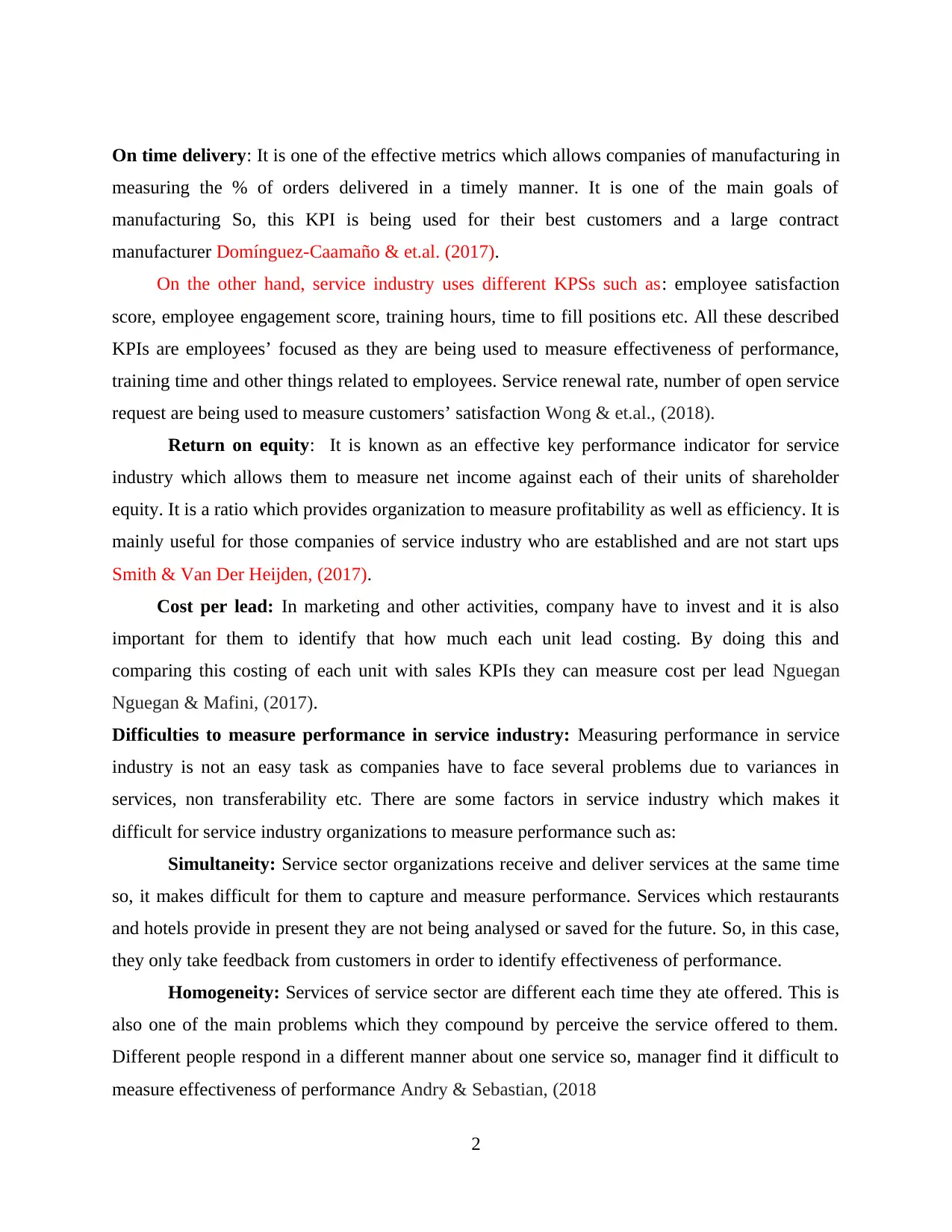
On time delivery: It is one of the effective metrics which allows companies of manufacturing in
measuring the % of orders delivered in a timely manner. It is one of the main goals of
manufacturing So, this KPI is being used for their best customers and a large contract
manufacturer Domínguez-Caamaño & et.al. (2017).
On the other hand, service industry uses different KPSs such as: employee satisfaction
score, employee engagement score, training hours, time to fill positions etc. All these described
KPIs are employees’ focused as they are being used to measure effectiveness of performance,
training time and other things related to employees. Service renewal rate, number of open service
request are being used to measure customers’ satisfaction Wong & et.al., (2018).
Return on equity: It is known as an effective key performance indicator for service
industry which allows them to measure net income against each of their units of shareholder
equity. It is a ratio which provides organization to measure profitability as well as efficiency. It is
mainly useful for those companies of service industry who are established and are not start ups
Smith & Van Der Heijden, (2017).
Cost per lead: In marketing and other activities, company have to invest and it is also
important for them to identify that how much each unit lead costing. By doing this and
comparing this costing of each unit with sales KPIs they can measure cost per lead Nguegan
Nguegan & Mafini, (2017).
Difficulties to measure performance in service industry: Measuring performance in service
industry is not an easy task as companies have to face several problems due to variances in
services, non transferability etc. There are some factors in service industry which makes it
difficult for service industry organizations to measure performance such as:
Simultaneity: Service sector organizations receive and deliver services at the same time
so, it makes difficult for them to capture and measure performance. Services which restaurants
and hotels provide in present they are not being analysed or saved for the future. So, in this case,
they only take feedback from customers in order to identify effectiveness of performance.
Homogeneity: Services of service sector are different each time they ate offered. This is
also one of the main problems which they compound by perceive the service offered to them.
Different people respond in a different manner about one service so, manager find it difficult to
measure effectiveness of performance Andry & Sebastian, (2018
2
measuring the % of orders delivered in a timely manner. It is one of the main goals of
manufacturing So, this KPI is being used for their best customers and a large contract
manufacturer Domínguez-Caamaño & et.al. (2017).
On the other hand, service industry uses different KPSs such as: employee satisfaction
score, employee engagement score, training hours, time to fill positions etc. All these described
KPIs are employees’ focused as they are being used to measure effectiveness of performance,
training time and other things related to employees. Service renewal rate, number of open service
request are being used to measure customers’ satisfaction Wong & et.al., (2018).
Return on equity: It is known as an effective key performance indicator for service
industry which allows them to measure net income against each of their units of shareholder
equity. It is a ratio which provides organization to measure profitability as well as efficiency. It is
mainly useful for those companies of service industry who are established and are not start ups
Smith & Van Der Heijden, (2017).
Cost per lead: In marketing and other activities, company have to invest and it is also
important for them to identify that how much each unit lead costing. By doing this and
comparing this costing of each unit with sales KPIs they can measure cost per lead Nguegan
Nguegan & Mafini, (2017).
Difficulties to measure performance in service industry: Measuring performance in service
industry is not an easy task as companies have to face several problems due to variances in
services, non transferability etc. There are some factors in service industry which makes it
difficult for service industry organizations to measure performance such as:
Simultaneity: Service sector organizations receive and deliver services at the same time
so, it makes difficult for them to capture and measure performance. Services which restaurants
and hotels provide in present they are not being analysed or saved for the future. So, in this case,
they only take feedback from customers in order to identify effectiveness of performance.
Homogeneity: Services of service sector are different each time they ate offered. This is
also one of the main problems which they compound by perceive the service offered to them.
Different people respond in a different manner about one service so, manager find it difficult to
measure effectiveness of performance Andry & Sebastian, (2018
2
Paraphrase This Document
Need a fresh take? Get an instant paraphrase of this document with our AI Paraphraser
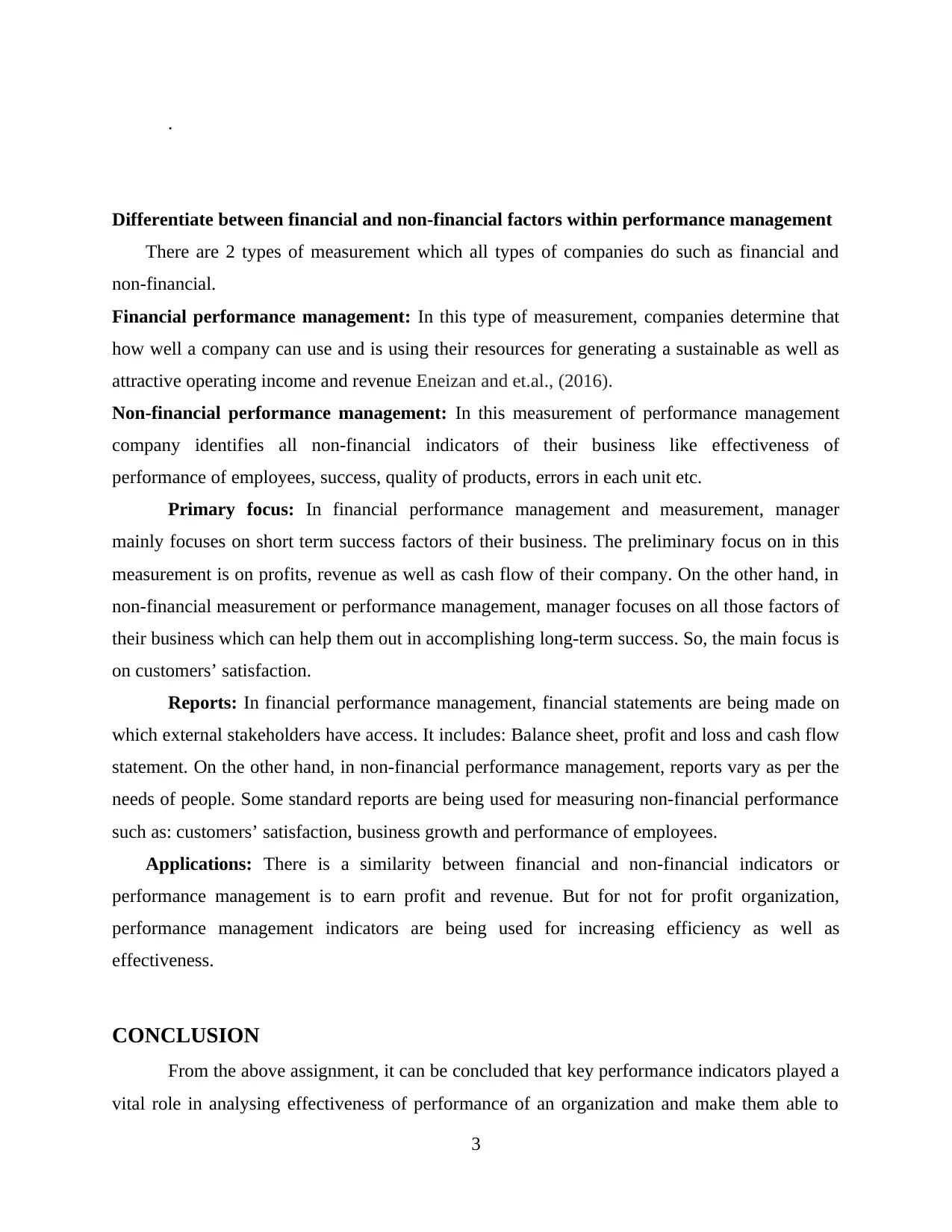
.
Differentiate between financial and non-financial factors within performance management
There are 2 types of measurement which all types of companies do such as financial and
non-financial.
Financial performance management: In this type of measurement, companies determine that
how well a company can use and is using their resources for generating a sustainable as well as
attractive operating income and revenue Eneizan and et.al., (2016).
Non-financial performance management: In this measurement of performance management
company identifies all non-financial indicators of their business like effectiveness of
performance of employees, success, quality of products, errors in each unit etc.
Primary focus: In financial performance management and measurement, manager
mainly focuses on short term success factors of their business. The preliminary focus on in this
measurement is on profits, revenue as well as cash flow of their company. On the other hand, in
non-financial measurement or performance management, manager focuses on all those factors of
their business which can help them out in accomplishing long-term success. So, the main focus is
on customers’ satisfaction.
Reports: In financial performance management, financial statements are being made on
which external stakeholders have access. It includes: Balance sheet, profit and loss and cash flow
statement. On the other hand, in non-financial performance management, reports vary as per the
needs of people. Some standard reports are being used for measuring non-financial performance
such as: customers’ satisfaction, business growth and performance of employees.
Applications: There is a similarity between financial and non-financial indicators or
performance management is to earn profit and revenue. But for not for profit organization,
performance management indicators are being used for increasing efficiency as well as
effectiveness.
CONCLUSION
From the above assignment, it can be concluded that key performance indicators played a
vital role in analysing effectiveness of performance of an organization and make them able to
3
Differentiate between financial and non-financial factors within performance management
There are 2 types of measurement which all types of companies do such as financial and
non-financial.
Financial performance management: In this type of measurement, companies determine that
how well a company can use and is using their resources for generating a sustainable as well as
attractive operating income and revenue Eneizan and et.al., (2016).
Non-financial performance management: In this measurement of performance management
company identifies all non-financial indicators of their business like effectiveness of
performance of employees, success, quality of products, errors in each unit etc.
Primary focus: In financial performance management and measurement, manager
mainly focuses on short term success factors of their business. The preliminary focus on in this
measurement is on profits, revenue as well as cash flow of their company. On the other hand, in
non-financial measurement or performance management, manager focuses on all those factors of
their business which can help them out in accomplishing long-term success. So, the main focus is
on customers’ satisfaction.
Reports: In financial performance management, financial statements are being made on
which external stakeholders have access. It includes: Balance sheet, profit and loss and cash flow
statement. On the other hand, in non-financial performance management, reports vary as per the
needs of people. Some standard reports are being used for measuring non-financial performance
such as: customers’ satisfaction, business growth and performance of employees.
Applications: There is a similarity between financial and non-financial indicators or
performance management is to earn profit and revenue. But for not for profit organization,
performance management indicators are being used for increasing efficiency as well as
effectiveness.
CONCLUSION
From the above assignment, it can be concluded that key performance indicators played a
vital role in analysing effectiveness of performance of an organization and make them able to
3

control activities accordingly. Further, it has also discussed some different KPIs for
manufacturing and service industries as well as some problems which these industries face in
measuring performance.
4
manufacturing and service industries as well as some problems which these industries face in
measuring performance.
4
⊘ This is a preview!⊘
Do you want full access?
Subscribe today to unlock all pages.

Trusted by 1+ million students worldwide
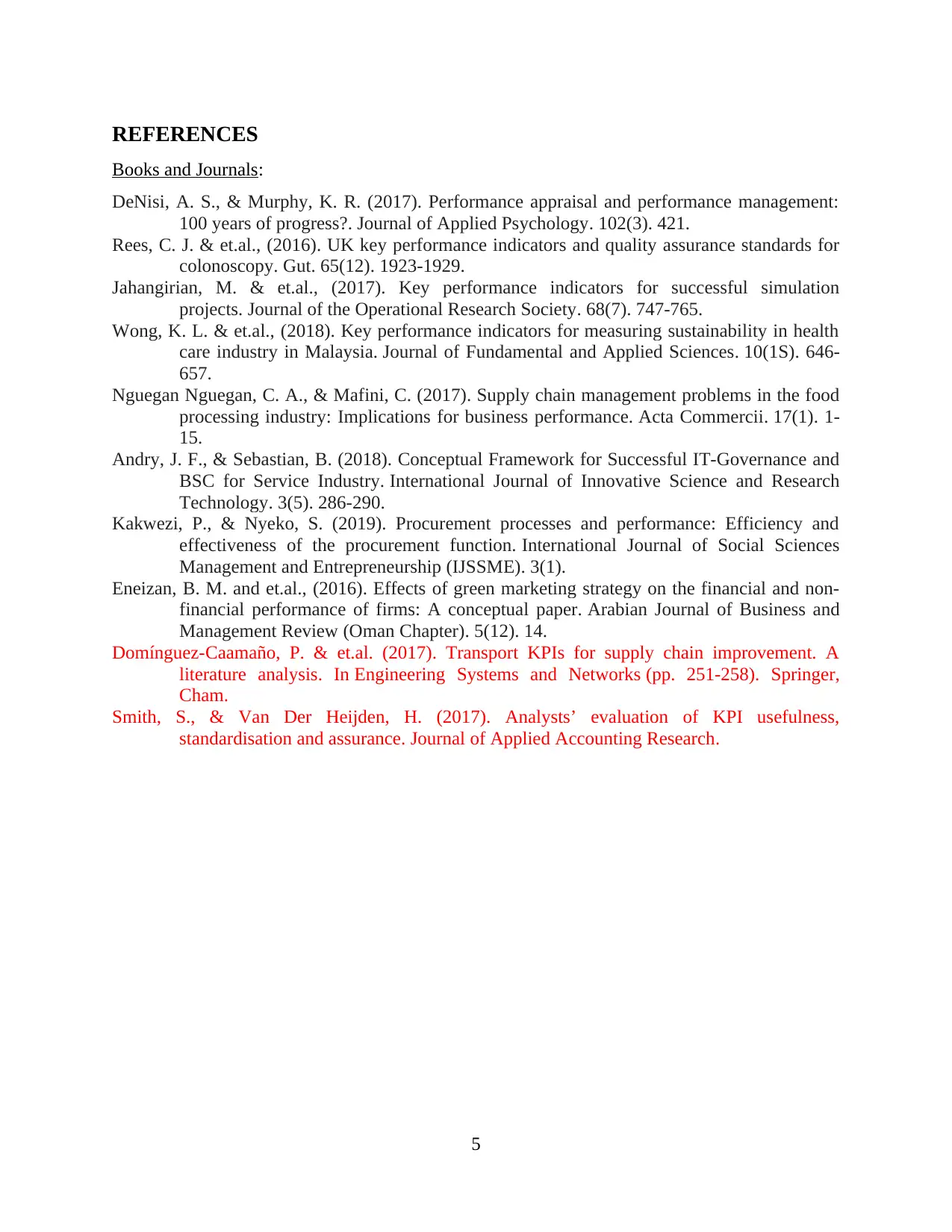
REFERENCES
Books and Journals:
DeNisi, A. S., & Murphy, K. R. (2017). Performance appraisal and performance management:
100 years of progress?. Journal of Applied Psychology. 102(3). 421.
Rees, C. J. & et.al., (2016). UK key performance indicators and quality assurance standards for
colonoscopy. Gut. 65(12). 1923-1929.
Jahangirian, M. & et.al., (2017). Key performance indicators for successful simulation
projects. Journal of the Operational Research Society. 68(7). 747-765.
Wong, K. L. & et.al., (2018). Key performance indicators for measuring sustainability in health
care industry in Malaysia. Journal of Fundamental and Applied Sciences. 10(1S). 646-
657.
Nguegan Nguegan, C. A., & Mafini, C. (2017). Supply chain management problems in the food
processing industry: Implications for business performance. Acta Commercii. 17(1). 1-
15.
Andry, J. F., & Sebastian, B. (2018). Conceptual Framework for Successful IT-Governance and
BSC for Service Industry. International Journal of Innovative Science and Research
Technology. 3(5). 286-290.
Kakwezi, P., & Nyeko, S. (2019). Procurement processes and performance: Efficiency and
effectiveness of the procurement function. International Journal of Social Sciences
Management and Entrepreneurship (IJSSME). 3(1).
Eneizan, B. M. and et.al., (2016). Effects of green marketing strategy on the financial and non-
financial performance of firms: A conceptual paper. Arabian Journal of Business and
Management Review (Oman Chapter). 5(12). 14.
Domínguez-Caamaño, P. & et.al. (2017). Transport KPIs for supply chain improvement. A
literature analysis. In Engineering Systems and Networks (pp. 251-258). Springer,
Cham.
Smith, S., & Van Der Heijden, H. (2017). Analysts’ evaluation of KPI usefulness,
standardisation and assurance. Journal of Applied Accounting Research.
5
Books and Journals:
DeNisi, A. S., & Murphy, K. R. (2017). Performance appraisal and performance management:
100 years of progress?. Journal of Applied Psychology. 102(3). 421.
Rees, C. J. & et.al., (2016). UK key performance indicators and quality assurance standards for
colonoscopy. Gut. 65(12). 1923-1929.
Jahangirian, M. & et.al., (2017). Key performance indicators for successful simulation
projects. Journal of the Operational Research Society. 68(7). 747-765.
Wong, K. L. & et.al., (2018). Key performance indicators for measuring sustainability in health
care industry in Malaysia. Journal of Fundamental and Applied Sciences. 10(1S). 646-
657.
Nguegan Nguegan, C. A., & Mafini, C. (2017). Supply chain management problems in the food
processing industry: Implications for business performance. Acta Commercii. 17(1). 1-
15.
Andry, J. F., & Sebastian, B. (2018). Conceptual Framework for Successful IT-Governance and
BSC for Service Industry. International Journal of Innovative Science and Research
Technology. 3(5). 286-290.
Kakwezi, P., & Nyeko, S. (2019). Procurement processes and performance: Efficiency and
effectiveness of the procurement function. International Journal of Social Sciences
Management and Entrepreneurship (IJSSME). 3(1).
Eneizan, B. M. and et.al., (2016). Effects of green marketing strategy on the financial and non-
financial performance of firms: A conceptual paper. Arabian Journal of Business and
Management Review (Oman Chapter). 5(12). 14.
Domínguez-Caamaño, P. & et.al. (2017). Transport KPIs for supply chain improvement. A
literature analysis. In Engineering Systems and Networks (pp. 251-258). Springer,
Cham.
Smith, S., & Van Der Heijden, H. (2017). Analysts’ evaluation of KPI usefulness,
standardisation and assurance. Journal of Applied Accounting Research.
5
1 out of 7
Related Documents
Your All-in-One AI-Powered Toolkit for Academic Success.
+13062052269
info@desklib.com
Available 24*7 on WhatsApp / Email
![[object Object]](/_next/static/media/star-bottom.7253800d.svg)
Unlock your academic potential
Copyright © 2020–2025 A2Z Services. All Rights Reserved. Developed and managed by ZUCOL.





